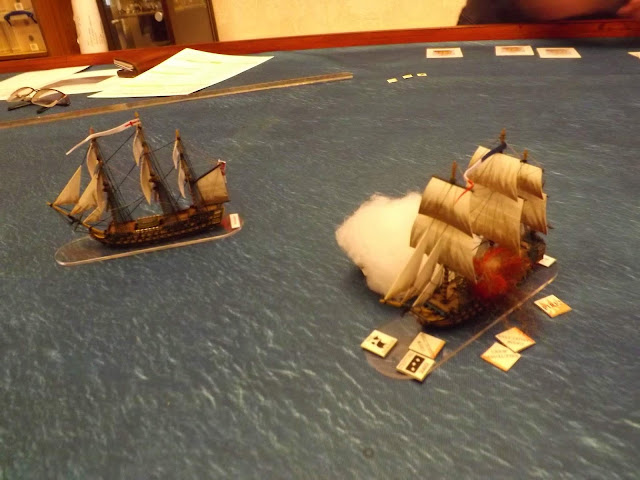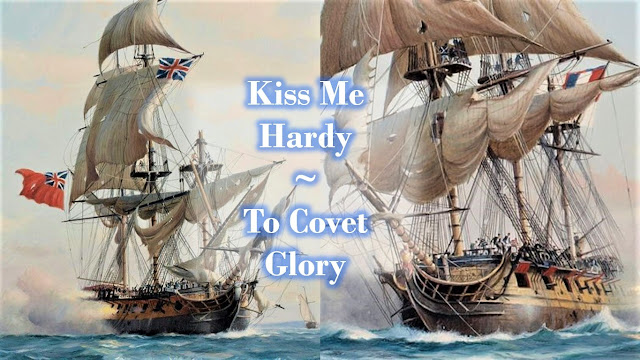One of the many projects I've been working on whilst completing my collection of age of sail miniature ships has been something long in the planning but that was put on the back-burner for a number of years whilst I awaited the launch of a range of models that would compliment the idea I had in mind.
When Warlord Games launched their collection of 1:700th models that allowed for the modelling of actions ranging from the great sea battles of the era to the much more common single ship and small squadron encounters I was immediately re-enthused with the idea of building a set of single and squadron ship encounters gleaned from the historical accounts of William James and his Naval History of Great Britain; that would allow the recreating of these historical actions, but with all the appeal to the eye that this scale of miniature facilitated in bringing these dramatic actions to life, while providing an informative, entertaining and mind challenging experience along the way.
In addition I wanted to make it very easy to pull out a scenario to take to club to play, that had all the set up information and background, the necessary analysis to produce a realistic measurement of success and failure based on what was at stake for the respective commanders, and all the factors they had to take into account, married with a set of ship sheets that reflected the historical statistics of the historical ships portrayed.
 |
| Kiss Me Hardy and To Covet Glory form the basis of my scenario planning |
This structure was to be built around my preferred set of rules Kiss Me Hardy and To Covet Glory which are great fun to play but, given the age of the original set, are in need of a few additions to bring them into line with more modern sets, that take into account fleet and squadron morale without detracting from the charm and appeal of the original set, which has been a labour of love over the last few years playing them on a regular basis.
Just recently I sat down to start work on some additional scenarios to add to the collection, now numbering fifty-two, and I was looking to work up a squadron scenario, useful for a club game where several of us all want to play in the same game, but with something a bit bigger than a frigate, and focussed my attention on a scenario that Jack and I play tested way back in 2020 on my table at home, with mixed success, and that left me not entirely satisfied that I had captured the look and feel of this encounter.
 |
| The Alexander dealing out destruction to the Droit's de l'Homme in my first attempt at replaying this interesting encounter in 2020. JJ's Wargames - All at Sea, First Games & New Rules |
We used a different set of rules that day and I didn't have the structure I have since incorporated for setting up these encounters based upon reading books such as Sam Willis, Fighting at Sea in the Eighteenth Century, The Art of Sailing Warfare, and the set of ideas made available from Curs'd Captain, in their free publication 'Narrow Seas, but seemingly no longer available following a recent check on Wargames Vault.
Since those early test games I have settled on the process of classifying each scenario set up as either a Chase or Meeting Engagement with the option left open to players to revert to either option as the game develops and the victory parameters are changed through circumstance, hence a captain may decide to run from an opponent with the upper hand in a meeting engagement, turning the scenario into a potential chase should the opponent choose to contest the attempted escape or the alternative where a chase turns into a meeting engagement when the quarry turns hunter perhaps due to damaging a pursuer sufficiently to allow him to counter-attack.
 |
| The Alexander at Bay game report can be read here on the DWG club blog Devon Wargames Group - The Alexander at Bay |
With the scenario 'Alexander at Bay', and the game we played just recently at the DWG and reported on the club blog in the link above, I laid out the description of events recorded by James, which on first reading would appear to be a Chase scenario, plain and simple, which is the way Jack and I originally played it.
However on a more thoughtful read it soon becomes obvious that Captain Bligh soon realised that flight was useless given the poor sailing qualities of his flagship the Alexander, and at some point he would be forced to turn and fight, immediately creating a meeting engagement, but one with some interesting twists.
So the first decision point was to have the chase set up constructed around that decision point reached by Bligh, with the Droit's de l'Homme closing to bow chaser range and sniping away at his rigging with the other French 74's in hot pursuit. This also required the poor sailing quality of the Alexander to be reflected in her basic speed of ten centimetres, two centimetres slower than all the other third rates on the table.
 |
| Let battle commence at the DWG with the respective forces set up ready to go. |
Before taking the decision to turn and fight, Bligh signalled his colleague and subordinate Captain Hamilton to close with him to present a formed defence against the onrushing French, a manoeuvre frustrated by Rear-Admiral Nielly who positioned his pursuing group in between the two British ships to prevent any such idea, however the signal put a requirement on Captain Hamilton to support Bligh as best he could and not simply run leaving the beleaguered Alexander to its fate, thus not leaving that option available to the British until compelled to by a failed Squadron break off test.
The latter point refers to my other main incorporation into my house rules covering fleet and squadron actions based on Preservation Point Values used to assess the break off point reached by a fleet commander when he assesses the losses suffered are too great to continue and thus signal a general retreat to the surviving force. This calculation resulting in a score of 3.3 PPV's for the French, with a third rate equivalent to 2 PPV and a flagship 3PPV meaning any two French ships (4 PPV's for two French 74's or 5 PPVs if one of them includes the flagship) striking would force a break off test.
 |
| Battle well and truly joined in our game, Alexander at Bay at the DWG |
Likewise the British calculation resulted in 2.5 PPV meaning that, based on the values above, should the flagship Alexander strike, the Canada would be forced to test to break off, but the loss of the Canada would not prevent Bligh from continuing to fight.
This break off test puts a pressure on both opposing commanders to go full in to win once the Alexander and Canada turn to fight, with the British looking to take the two leading French pursuers out of the attack and hope that the others leave them to their fate by being compelled to break off, but failing that seeing the French looking to gang up on the British quickly to prevent such a threat and to take either both of them or at least the Alexander thus forcing the Canada to attempt to run and potentially face a pursuit to prevent her escape, that would bring in the 'escape rules' for such occasions to determine if that will occur over two turns following the declaration to escape being made, with failure resulting in the striking of the attempting escapee.
One final point worth stressing is that these third rates are not the more powerful types that came to typify the two navies in the later Napoleonic era and their hull factors and gunnery stats reflect ships with a tonnage of around 1600 tons bm., rather than the later ships up to and around 1800 tons bm.
Also the ships take into account the better training of the two British crews, still only rated as 'average' and not elite Jolly Jack Tars, again reflecting the early part of the war when crews were still working up their greater percentage of landsmen recently 'volunteered' for service in the navy and so the five French ships rated average Sans Culottes, reflecting these crews being the best the French dare send out at this stage of the war, make this a very well matched action, with both sides able to take advantage should the opportunity present.
This is a basic summary of my thinking when constructing the games we have been playtesting at club and so far it has been really great to see the players quickly identifying how best they should make use of their respective strengths to overcome the weaknesses of theirs and their opponents forces and to perform better than their historical counterparts, perhaps the best way to assess victory or defeat when recreating these historic encounters.







No comments:
Post a Comment